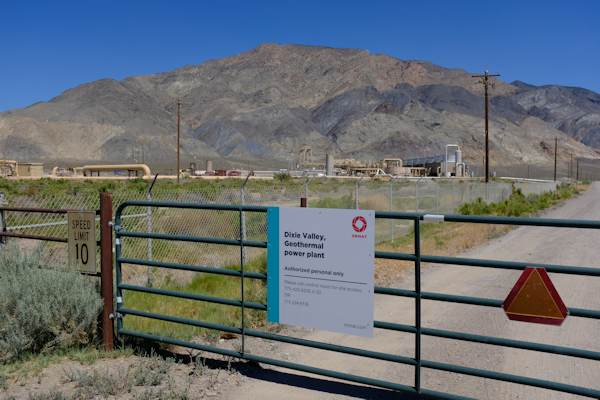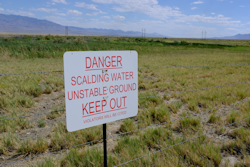SEJournal Online is the digital news magazine of the Society of Environmental Journalists. Learn more about SEJournal Online, including submission, subscription and advertising information.
 |
| Sites with potential for producing geothermal energy are rare, hard to find and sometimes controversial. Above, the Dixie Valley geothermal plant at the foot of the Stillwater Range in Nevada. Photo: Jessica McKenzie. |
Feature: What Will It Take for Geothermal To Heat Up the Renewable Energy Sector?
By Jessica McKenzie
Geothermal energy’s potential contribution to reducing greenhouse gas emissions is enormous. Just 0.1 percent of the Earth’s heat could provide enough energy to power the world for two million years. And every gigawatt of energy from geothermal resources offsets approximately 380 metric tons of carbon dioxide emissions.
Yet geothermal energy is responsible for less than 1% of the total electricity generation in the United States.
So why has it been so slow to tap into this vast and essentially inexhaustible resource? And how might that soon change?
How geothermal energy works
The optimal geothermal systems for geothermal energy have three key characteristics: heat, fluid and permeability.
“Heat” really means access to heat. Most existing geothermal plants are located where there’s a lot of tectonic activity and the Earth’s crust is relatively thin, like Iceland, western Turkey, parts of New Zealand and the Great Basin of the western United States. The closer those high temperatures are to the surface, the easier (and therefore cheaper) it is to drill down to them.
Fluid is necessary to draw energy in the form of heat out from the ground. There are several types of geothermal systems and each one uses fluid in a slightly different way.
Steam plants use the naturally occurring steam from geothermal systems to turn a turbine, which is used to generate electricity.
 |
| This hot-spring-fed meadow is home to the Dixie Valley toad. Concerns for this endangered species have halted the construction of a nearby geothermal project. Photo: Jessica McKenzie. |
Flash plants pump geothermal fluids into a low-pressure tank, causing it to vaporize or “flash” into steam, which then turns a turbine.
Binary systems — which can make use of geothermal temperatures as low as 248 F (120 C) — use geothermal fluid to heat a secondary fluid with a lower boiling point than water, using the steam from the secondary fluid to spin a turbine. The geothermal fluid or “brine” is then reinjected back into the ground.
Finally, permeability is necessary so the water in the geothermal system can be replenished and the cycle can continue.
The problem is, there are a limited number of sites where the geothermal industry knows these conditions definitely — or at least likely — exist.
On top of that, these sites can have unique ecosystems associated with them and geothermal production can threaten endangered plants and animals, like steamboat buckwheat or the Dixie Valley toad.
If geothermal is to be scaled to its full potential, the industry must either find more sites, particularly sites that are less ecologically sensitive, or create them.
The hunt for hidden geothermal systems
Most existing geothermal plants have been built in places that now have or once had surface expressions of geothermal activity, like hot springs or fumaroles.
These geological features are basically giant flags indicating the presence of the magic trio of heat, water and permeability. Not all such sites will be suitable for geothermal energy production, but there’s a good chance they might be.
However, there are a few geothermal systems that were only found by happenstance — in the course of oil or mineral exploration, for example. And geologists believe that there are many more such hidden or “blind” systems that have no surface expression.
Experts estimate that between 40% and 75% of the Great Basin’s geothermal systems may be hidden.
Bridget Ayling, the director of the Great Basin Center for Geothermal Energy at the University of Nevada, Reno, studies how to find those systems using machine learning and advanced geostatistics. Ayling and her colleagues take over a dozen data points available for known geothermal systems and use them to find other locations that share many of the same characteristics.
One of the biggest barriers to geothermal expansion is the high cost of exploration, or “drilling around and finding out.” It’s expensive and time-consuming, since companies must secure permits before they can even begin drilling exploratory wells and if they don’t turn anything up, well, that’s the cost of doing business.
Ayling and her colleagues aim to increase the chances that if the data say drill here, a company is likely to find a viable geothermal system. The extent to which they succeed will determine how many of these hidden systems can be found and exploited.
DOE’s Energy Earthshot
The alternative to finding hidden geothermal systems is to make them. These are called enhanced or engineered geothermal systems and they are still solidly in the prototype stage.
The basic idea is simple: If you can drill
deep enough, pretty much anywhere
on Earth, you’ll eventually hit heat.
The basic idea is simple: If you can drill deep enough, pretty much anywhere on Earth, you’ll eventually hit heat. So if developers can add permeability by fracturing those hot rocks and then introduce water, they can create a human-made geothermal system.
The technology has the potential to increase geothermal electricity production in the United States by fortyfold.
But James Faulds, the Nevada state geologist and director of the Nevada Bureau of Mines and Geology, estimates that its realization is still several decades off.
The U.S. government is investing significant sums in this technology through its Fourth Energy Earthshot. In 2022, the Department of Energy announced that it would spend $44 million in enhanced geothermal systems research and earmarked another $84 million for pilot projects.
That’s in addition to the $165 million the agency plans to spend to expand and improve geothermal energy across the board.
Seizing the lowest-hanging fruit
Discussions of geothermal energy often focus on its potential to generate electrical power, but geothermal energy doesn’t necessarily have to mean electricity.
Low- to moderate-temperature geothermal systems with fluid temperatures between 68 and 300 F (20 to 149 C) can be used directly to heat buildings and greenhouses, de-ice roads and sidewalks or heat water.
Heat pumps, which use temperature exchangers to remove heat from the ground and pump it into a building, are an even simpler option. They also work in reverse in the hotter months, taking hot air from inside buildings and exchanging it with cooler air from the ground.
The costs of investing in direct use can be high, but so is the payoff.
One casino and hotel resort in Reno spent almost $10 million to install a geothermal heating system for hot water and building heating and cooling. This investment was expected to pay itself off in five years, but it only took three, and the system has since saved the resort millions in heating and cooling costs.
In Paris, France, a direct-use district heating system has reduced the city’s annual carbon footprint by 120,000 tons.
Meanwhile, efforts to find hidden geothermal systems or create them from scratch continue, and known geothermal sites are attracting increasing attention.
Geothermal has been the next big thing for a few years now, but with major investments from federal, state and local governments coming in, this could be the year for it to really catch fire.
Jessica McKenzie is an associate editor at the Bulletin of the Atomic Scientists, where she writes and edits stories about climate change and the environment, and a member of the Society of Environmental Journalists. Her writing has been published in The New York Times, National Geographic, Audubon Magazine, Backpacker, The Counter and Grist. In 2021, Outside Magazine named her monthly newsletter, Pinch of Dirt, one of the “Best Outdoorsy Email Newsletters.”
* From the weekly news magazine SEJournal Online, Vol. 8, No. 11. Content from each new issue of SEJournal Online is available to the public via the SEJournal Online main page. Subscribe to the e-newsletter here. And see past issues of the SEJournal archived here.












 Advertisement
Advertisement 



